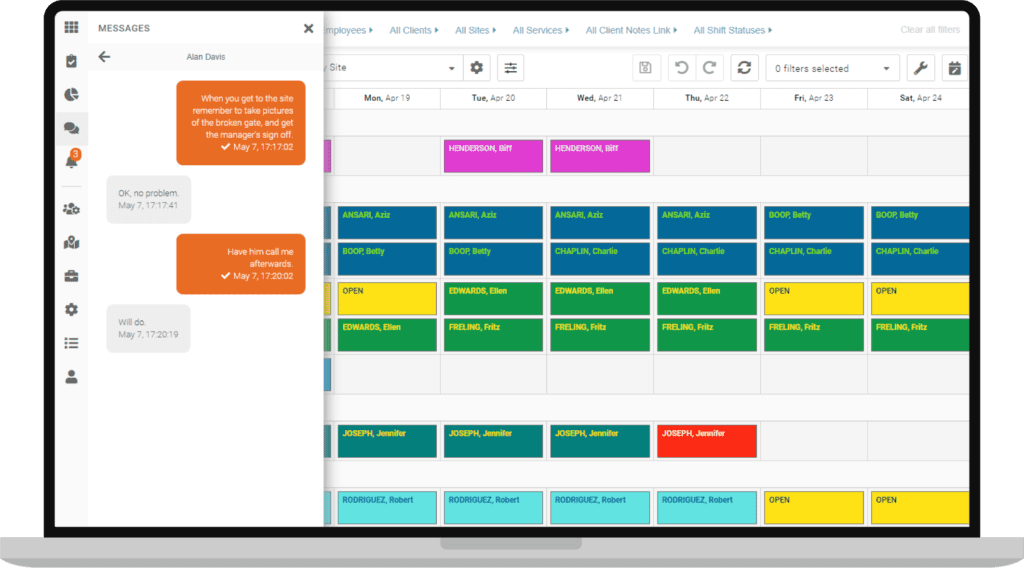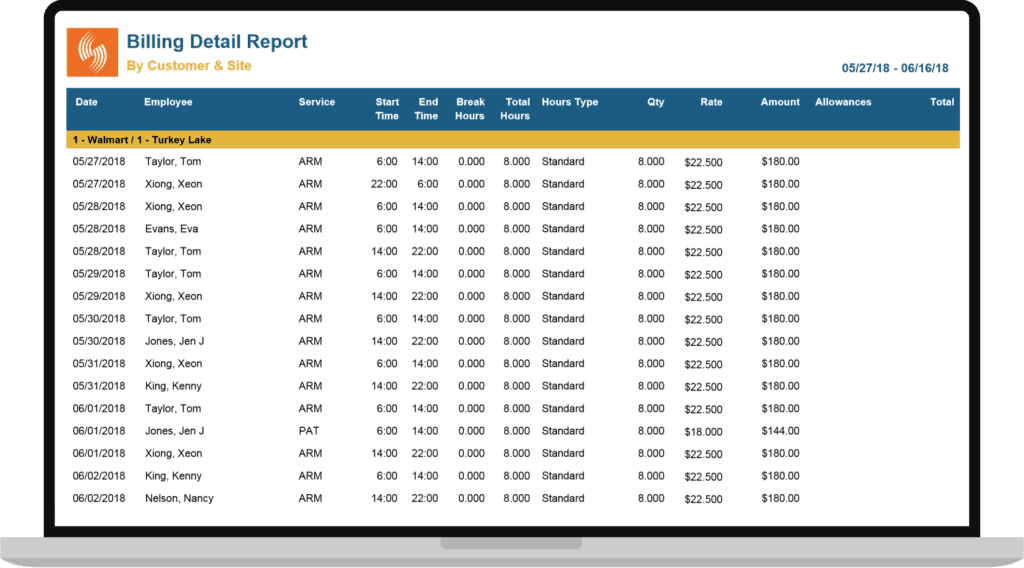No matter which industry you work in, the word ‘automation’ has likely come up somewhere in your work conversation. Automation is a process that businesses undertake within their operational processes to decrease the amount of manual input. Generally, technology is at the heart of automation. So, how can automated workforce management help?

The benefits of automation in workforce management are often understated compared to its benefits for the consumers. Workforce Management Systems are designed to streamline a company’s internal processes. Generally, they also increase employees’ productivity. To get the best out of the employees, businesses seek automation to help decrease certain repetitive or time-consuming tasks.
The objectives of workforce management are to help balance the workload and increase productivity and flexibility. By definition, it’s getting the right people in the right place at the right time. Automation has the capabilities to fulfil these objectives. So, why should you consider automated workforce management in your workplace?
Why do you need Automated Workforce Management?
1) Improve processes
Just like technology was introduced in manufacturing processes to decrease manual effort, automation is available for workforce management to ease the burden on your employees. Automated workforce management provides a platform for businesses to effectively streamline repetitive and time-consuming processes. These include payroll processes, time and attendance management, and various scheduling issues. All these processes are vital for business functioning yet can consume a lot of time away from employees’ jobs.
2) Save time

As mentioned above, workforce management processes are very time-consuming. Modern automated systems solve this issue by taking responsibilities away from the employees. They efficiently find solutions that sometimes overworked employees are unable to.
Overall, the time consumed by labour-intensive administrative functions can be very wasteful and prone to errors. This further enforces the need for automation.
3) Reduce Error
Human error is inevitable and expected. When it comes to workforce management, these errors can be extremely costly! Taking payroll errors as an example; payroll errors cost US businesses up to 8% of their total payroll costs, according to the American Payroll Association.
This happens by over-paying employees, or paying fines associated with common payroll errors. Businesses look towards technology to reduce such errors, whether in critical manufacturing and delivering processes or data collection.
Similarly, automation potentially cuts down on various types of errors and ensures accuracy. As a result, it’s become necessary to have automation present in error-prone systems such as payroll services. This can help with accounting issues as well as employers with scheduling and logistical issues.
4) Competitive Advantage
Artificial Intelligence is becoming rapidly popular as an automation tool. As per a report by Appen in 2021, 62% of organisations are using AI to support IT operations.
- 54% use it to improve business process efficiency
- 48% are supporting manufacturing operations
- 49% are using AI for research and product development.
Consequently, automation is becoming very prominent with businesses, and manual processes are becoming outdated. Businesses are seeking automation in order to remain in line with their competitors. Currently, 29% of companies plan to implement business process management software in the near future, including companies like Deloitte. The numbers are only likely to increase, which will add extra pressure on businesses to compete by implementing the same.
Effective workforce management also enhances customer experience. When the right people are in the right place at the right time, your customers or clients are happy. When you’re consistent with that, you have a major competitive advantage over others in your industry.
Now that you know why automation is necessary for workforce management, let’s look into what automated workforce management looks like.
Automated Workforce Management

According to Grand View Research, the market for workflow automation management systems is expected to grow from $4.8million in 2018 to exceed $26 billion by 2025!
This shows a new challenge at work: How can we use automation to our advantage?
While a Mckinsey report from 2019 suggested that one-third of the tasks in two-thirds of current jobs could be automated, there are few specific workforce management processes that your business could vastly improve immediately. Let’s take a look.
Employee Scheduling
Employers often give themselves the responsibility of employee scheduling, assuming that they have experience in making last-minute scheduling changes. While this may bring out their spontaneous side, it prevents the employers from contributing their expertise elsewhere. As a result, employers could look towards automation to develop an efficient employee scheduling system.
There are quite a few features that automated systems like Celayix’s scheduling software provides. Firstly, our autofill feature can fill in a schedule based on qualifications set by the business and assigns staff automatically. With the help of this feature, business can be more transparent and fair in their scheduling.
Not only that, but because of our rules-based engine for scheduling, these tools are fully customizable. This way, businesses are more likely to optimize their schedules as well as come up with solutions at a faster rate.
Another feature within Celayix’s scheduling software is the Find Replacement feature. This feature is completely automated and makes last-minute no-shows, sick calls, and other last-minute changes easy to deal with. Rather than calling multiple employees at the last minute to come in for a shift, this feature automatically searches for the most suitable employee for the shift within the roster. This helps save a lot of time and money in the process!
Time & Attendance:
Time & Attendance is a crucial aspect that businesses continuously work upon to benefit workforce management. The time collection of employees can be very tricky, and as numbers increase, it’s challenging to be on track with clocking in and out of each employee. As a result, businesses use automated features that quickly carry out such operations to ensure that payroll or other services have an exact idea of the amount of time any employee works.

For instance, Celayix’s automated attendance matching feature collects the time each employee works in its shift and sends the information to the payroll department to pay the wages correctly. This tool helps compare hours worked with the hours scheduled. What’s the difference? Whenever an employee works for longer or less than the hour scheduled, the employee should likely be paid differently from what was initially planned.
The automated attendance matching feature not only collects the time of each employee, reviews the schedule, compiles the data and transfers to the payroll provider, but it can be integrated with the payroll processes. Consequently, through automation, businesses save money and time by letting AI decide how many hours an employee has worked and should be paid for!
Budgeting & Forecasting:
Budgeting and Forecasting are some of the most challenging tasks for any business to make, and they are essential in workforce management. Without having a clear plan for the budgets in your business, it’s unlikely that any workforce can be managed. Often businesses seem to look at historical data to identify periods of high activity and hence require more significant budgeting. Market and industry trends help decide when there is a requirement for workforce resources and when there is not.
While it’s possible to manually forecast the need for labour or other resources during events, it’s very likely that sometimes businesses miss opportunities or might over employ for an event. Instead, businesses could use the automated labour forecasting system that allows employers to quickly create batches of shifts depending on the type of specified event and the number of guests/consumers attending. All in all, automation can facilitate budgets, organize resources and be prepared for any event.

Business Analysis:
The key to business growth and success is business analysis. This helps you identify the strengths and weaknesses of your business and its operations and help find solutions. Modern technology can come of great help here. How so?
Automated technology can find and collect actionable business data to help business analysts have a resource to work with. The data collected can often be reduced and represented in a manner that makes the work for a business analyst much lesser and easier. Subsequently, automation benefits can work as a facilitator for employers and employees of the company to grow their business.
By now, you have likely identified the three critical aspects of workforce management: time, money and productivity. The downside of not having automated workforce management is losing precious time and money, which is key in growing any business. Automated processes are built to help conserve time and money and help your workforce become more productive and happier. If you’d like to see Celayix automated workforce management in action, request a free live demo today!





